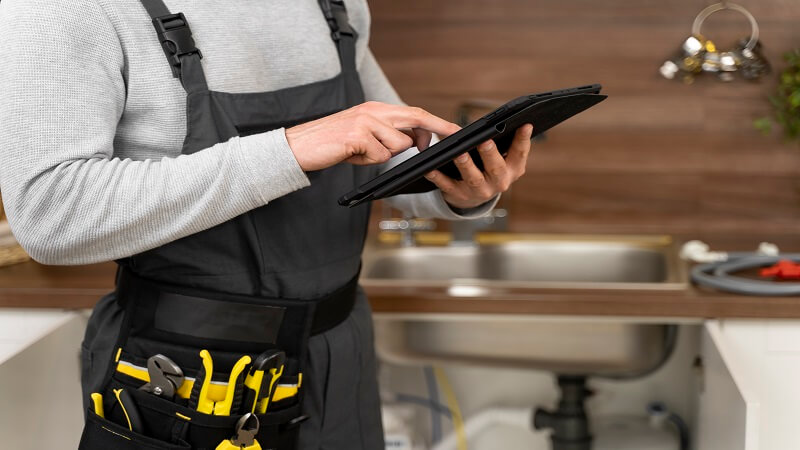Moving into a new home? Start by inspecting your plumbing system to avoid surprises later. Check water pressure, test all faucets and drains, examine the water heater, and look for leaks or corrosion. If you spot any issues, it’s wise to consult professional plumbers who can help resolve them efficiently. A proactive approach secures your plumbing remains reliable and problem-free.
Table of Contents
- Pre-Move-In Inspection: What to Look For
- Essential Maintenance Tips for Your Plumbing System
- Common Plumbing Problems and How to Address Them
Buying a new home is an exciting milestone, but it also comes with responsibilities – especially when it comes to plumbing. Imagine hosting your first dinner party in your new space, only to discover that the kitchen sink won’t drain or the shower has no hot water. These scenarios might sound minor, but they can quickly escalate into costly repairs if left unchecked.
Plumbing systems are the backbone of any home, yet they’re often overlooked until something goes wrong. Whether it’s a dripping faucet, a mysterious leak under the sink, or inconsistent water pressure, these issues can disrupt your daily routine and lead to frustration. Many homeowners find that addressing potential problems early – whether on their own or with the help of Quicker Rooter plumbers – can save both time and money in the long run.
So, here in this guide, we will take you through all that you should know including how to perform a pre-move-in inspection as well as the maintenance of your system and how to know when to call in the experts. These steps will give you a stress-free homeownership. Shall we begin!
Pre-Move-In Inspection: What to Look For
Before you start unpacking boxes or arranging furniture, take the time to thoroughly inspect your new home’s plumbing system. This step is crucial because it helps you identify potential issues early, saving you from costly repairs down the line. Think of it as a “plumbing health check” for your home.
Here’s how to approach this process:
1. Test Water Pressure Across the House
Water pressure is one of the first things to check. Low water pressure could indicate clogged pipes, a malfunctioning pressure regulator, or even issues with the municipal water supply. On the other hand, excessively high pressure can strain your pipes and fixtures, leading to leaks over time. Test faucets, showers, and outdoor spigots to secure consistent flow throughout the house.
2. Inspect for Leaks and Corrosion
Leaks don’t always announce themselves with puddles on the floor. Look for subtle signs like water stains on ceilings or walls, damp spots under sinks, or musty odours in certain areas. Pay special attention to older homes, where corroded pipes might be lurking behind walls. If you notice any greenish or rust-like buildup around pipe joints, it could signal corrosion that needs immediate attention.
3. Check All Drains and Fixtures
Run water through every drain in the house – bathtubs, sinks, showers, and floor drains – to confirm they’re functioning properly. Listen for unusual sounds like gurgling, which could indicate a clog or venting issue. While you’re at it, test all faucets and showerheads for proper operation. Dripping faucets might seem minor, but they can waste significant amounts of water if left unchecked.
4. Examine the Water Heater
The water heater is often overlooked during move-in inspections, but it plays a critical role in your daily comfort. Check its age (most units last 8–12 years), condition, and thermostat settings. Look for signs of rust, leaks, or strange noises when it’s running. If the unit appears outdated or shows visible wear, consider whether replacement might be necessary sooner rather than later.
5. Locate and Test Shut-Off Valves
Every homeowner should know where the main water shut-off valve is located – and secure it works properly. This simple step can prevent major damage in case of a burst pipe or other emergency. Don’t forget to test individual shut-off valves under sinks, toilets, and appliances like washing machines. A stuck valve can make small repairs much more complicated.
Essential Maintenance Tips for Your Plumbing System
Once you’ve settled into your new home, maintaining your plumbing should become part of your regular routine. Just like changing the oil in your car or cleaning out your gutters, these small tasks can prevent big problems later on. The good news? Most maintenance tips are simple enough for any homeowner to handle, and they don’t require a lot of time or effort.
Here’s how to keep your plumbing system running smoothly:
1. Monthly Tasks to Keep Things Flowing
- Clean Faucet Aerators: Mineral deposits from hard water can clog aerators, reducing water flow. Simply unscrew the aerator (usually at the tip of the faucet), soak it in vinegar, and scrub away buildup with a small brush.
- Flush Your Water Heater: Sediment accumulation in your water heater reduces efficiency and shortens its lifespan. Attach a hose to the drain valve, flush out a few gallons of water, and repeat until the water runs clear. If you’re unsure about this process, consult professional plumbers for assistance.
2. Seasonal Tasks to Prevent Costly Repairs
- Inspect Outdoor Hoses and Spigots: Before winter arrives, disconnect garden hoses and drain outdoor spigots to prevent freezing and bursting. For added protection, install frost-free hose bibs if your home doesn’t already have them.
- Clear Gutters and Downspouts: While not directly part of your plumbing, clogged gutters can lead to water pooling near your foundation, which may cause leaks or structural damage over time.
3. Annual Tasks for Long-Term Peace of Mind
- Schedule a Professional Inspection: Even if everything seems fine, an annual check-up by professional plumbers can catch hidden issues before they escalate. They’ll assess your pipes, drains, and appliances to secure everything is functioning optimally.
- Replace Worn-Out Components: Over time, washers, seals, and gaskets in faucets and toilets wear out, leading to drips or leaks. Replacing these parts annually is an easy way to maintain efficiency and avoid unnecessary water waste.
Common Plumbing Problems and How to Address Them
Plumbing problems may still occur even when the very best maintenance habits are employed. The trick is to know how to detect them early and also knowing when you should perform your own repair or when it is time to bring in the specialists. Let us check out some of the most typical issues in plumbing that new homeowners may encounter and what you can do with them below.
1. Clogged Drains
Clogs are among the most frequent plumbing headaches, especially in kitchens and bathrooms. Hair, soap scum, food particles, and grease can build up over time, slowing drainage or causing backups.
- DIY Fix: Start by using a plunger to dislodge the clog. If that doesn’t work, try a drain snake or a mixture of baking soda and vinegar followed by hot water. Avoid chemical drain cleaners, as they can damage pipes over time.
- When to Call a Pro: If the clog persists or affects multiple drains, it could indicate a deeper blockage in your main sewer line – something only professional plumbers should tackle.
2. Leaky Faucets
A dripping faucet might seem like a minor annoyance, but it can waste hundreds of litres of water annually if left unchecked. Most leaks stem from worn-out washers, O-rings, or cartridges.
- DIY Fix: Turn off the water supply, disassemble the faucet, and replace the damaged components. Hardware stores often sell repair kits specific to faucet models, making this an easy fix for handy homeowners.
- When to Call a Pro: If the leak continues after replacing parts or if you’re dealing with a complex fixture like a touchless faucet, it’s best to consult a professional.
3. Running Toilets
A toilet that runs constantly not only wastes water but also drives up your utility bill. This issue is typically caused by a faulty flapper, float mechanism, or fill valve.
- DIY Fix: Open the tank and inspect these components. Adjust the float height or replace the flapper if it’s worn out. Many hardware stores sell universal replacement parts that are easy to install.
- When to Call a Pro: If adjustments don’t stop the running sound, there may be a more serious issue, such as a cracked tank or internal damage requiring expert attention.
4. Frozen Pipes
In colder climates, frozen pipes are a real concern during winter months. When water freezes inside pipes, it expands, potentially causing cracks or bursts that lead to flooding.
- DIY Fix: If you notice frost on your pipes or no water flow, turn off the main water supply immediately. Use a hairdryer or heating pad to gently thaw the pipe, starting from the faucet and working backward. Never use an open flame, as it can damage the pipe or pose a fire hazard.
- When to Call a Pro: If a pipe bursts or you’re unable to locate the frozen section, professional plumbers have specialized tools to address the problem safely and efficiently.
5. Low Water Pressure
Low water pressure can make everyday tasks frustrating, whether it’s taking a shower or washing dishes. Causes range from clogged aerators to hidden pipe damage.
- DIY Fix: Begin by cleaning faucet aerators and checking for partially closed shut-off valves. If those steps don’t help, inspect your home’s pressure regulator (if installed) for malfunctions.
- When to Call a Pro: Persistent low pressure across multiple fixtures could signal a larger issue, such as corroded pipes or municipal supply problems. A plumber can diagnose and resolve these underlying causes.
Final Thoughts: Staying Ahead of Plumbing Issues
The plumbing of your house is similar to the circulatory system of your body, it is what makes everything run well and makes sure that everyday life goes on without a problem. Being a new homeowner, there are few better ways of safeguarding your investment and keeping your peace of mind than assuming ownership of this essential system.
The lesson here? It is worth being proactive. Though a careful pre-move-in inspection, keeping up with regular maintenance and dealing with problems in advance, you can avoid those little nuisances that can become big problems. Of course, DIY repairs always work well as far as minor work is concerned; however, professional plumbers are always the best choice in case of complicated repairs or upgrades.
Keep in mind that plumbing is not only about conducting repair work, but rather it is about building a stable basis of your house. It can be a maintenance of the even water pressure, leak prevention, or simply updating ancient systems, but all the steps lead to a more comfortable and efficient place to live.

